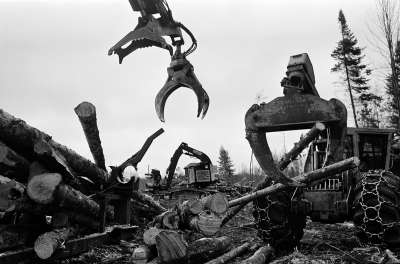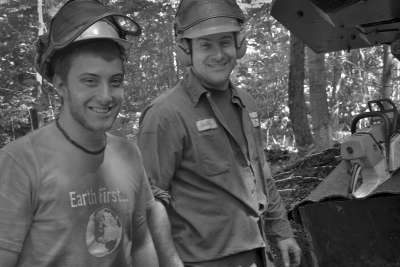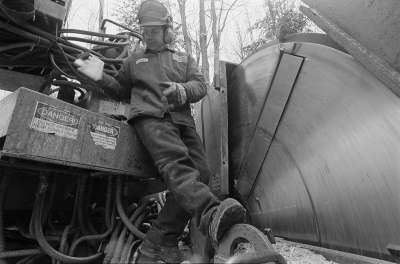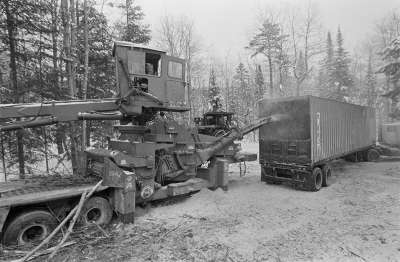
With much of the forest’s output subject to commodity pricing, survival for mechanized loggers depends on the efficiency and economics of big machines. Justin Lathrop is the machine guy at his family’s six generation logging business, Lathrop Forest Products, in Bristol, Vermont. Here, Justin tells writer and photographer George Bellerose about the high costs of highly productive, high-tech logging equipment.
My father never bought anything new. He’d buy stuff that was 10 to 15 years old. It could be a real pile of junk and he’d make it work.
The only pieces of forestry equipment that he bought new, until the very end, were the John Deere 400G bulldozer and a log loader. He put the loader on a rebuilt truck.
Back then, you could fix things. When I go to machinery expos today, it scares me when I look under the hood. It’s all electronics, and I can’t fix that. My philosophy is, “Don’t buy it if you can’t fix it.” The question is when do you trade? You figure 10,000 hours for a motor. I don’t fear buying an older piece of equipment if the frame is good. Everything else is just replaceable parts; you can put in a second motor. Our 2003 Timbco T445D feller-buncher has 13,200 hours and it’s never been touched except for routine maintenance. It’s all mechanical. There are no electronics except for a small computer to help run the processing head. It’s paid for, and I don’t have to run it every day. If you buy new, you have to run hard every day and cut in some bad weather.
When [my brother] Jason and I bought our first new skidder, we saw three years of work ahead of us. That was 1996, when we had a dozen government contracts. The old man had made us fix junk for so long that we had had enough. I wanted to work in the woods, not be a mechanic. The problem is what we get for our logs hasn’t changed much in 25 years. The cost of logging equipment has. We need to upgrade, but only with equipment that will help our workflow.
Right now, with our equipment, we can handle just about any job. If we need to put in a road, we have a bulldozer and an excavator. We can cut to length. We can do whole-tree. We can chip onsite and in the yard. We have cable and grapple skidders. We have a forwarder. We have slashers and chippers and half a dozen trailer trucks. I don’t think there is anybody [else working in this area] who could do everything that we do. You need backups, and we have two of everything.
Our weakest link is our second feller-buncher (a 1997 Tigercat 845). It was half a dozen years old when we got it for $69,000. A new one runs $300,000–$400,000. That’s out of the question.
We can’t run the Tigercat hard because the motor doesn’t have the power or enough cooling capacity. It also doesn’t have leveling like the Timbco does, which makes it hard to get anything done on steeper ground. You have to go straight up and straight down. You can’t go sideways with it on hills. It’s just frustrating to run and nowhere near as efficient as the Timbco.
I’ve been planting the seed with Jason to replace it. I have been looking for another Timbco 2003 so we could share parts. That would probably cost us a hundred and a quarter, but it would be worth it. You just have to be lucky to find one. The 2003 was probably the best model ever, and people hold on to them. This is a national market. It doesn’t have to be in New England. I’m not afraid to buy something out west. Fly out, and if it’s something we want, I bring it back.
Chippers are the next real expensive piece of equipment that we have to watch. Right now, we have three, which pretty much covers our needs.
We have two that can handle trees up to 27 inches in diameter. They’re both portable. Our 22–inch model is strictly a backup and never leaves the yard. All our chippers are from the ’80s, and we can fix everything on them. A new chipper would probably go $600,000. You’d have to push a lot of wood through to afford that. We’re at the point now where if we get any bigger, we will need two crews. We have bottlenecks because the feller-buncher can cut trees in the woods faster than we can cut or chip them at the landing.
We bought a forwarder so we could cut whole trees to length in the woods and not have to cut them at the landing. Tracked forwarders are easier on the land than skidders and have improved our flow. We are considering getting another. With all our equipment, we need a new service truck. Fully equipped, that would run $120,000.
Whatever we do, there is no way that we can buy new. We will just keep crawling up the ladder with something a little better. That’s all we can do.





